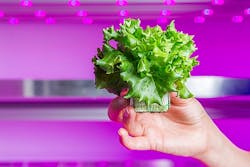Philips adds dynamic color mixing to its horticultural LED lighting system
Growers can use one horticultural LED lighting fixture to change 'light recipes,' rather than purchasing a separate light for each color.
Philips Lighting will soon make it easier for farmers to adjust light frequencies — “light recipes” — on indoor crops, as it introduced an LED fixture with four different colors that growers can mix and change for the desired effect on a plant's size, shape, and other attributes.
Interested in news & announcements on horticultural LED lighting?
The Philips GreenPower Dynamic LED horticultural system lets growers vary the contribution of four different colored diodes — blue, red, far red, and white — to create any color frequency, using one fixture which Philips plans to ship in the fourth quarter including hardware and software.
A lollo bionda lettuce under purplish horticultural LED lighting emitted by combined red and blue frequencies, which can stimulate changes in photosynthesis and in a plant's shape.
“This takes us a step further,” Gus van der Feltz, global director of city farming for Philips Lighting horticultural LED solutions, told LEDs Magazine. “Our previous platform had individual fixtures that had just had one color which you could use next to each other to create a combination of light. What we've done now is we've integrated it into one fixture.”
LEDs Magazine has announced its one-day Horticultural Lighting Conference! Visit horticulturelightingconference.com
to learn more.
Growers with horticultural LED lighting systems can optimize red frequencies to stimulate photosynthesis and thus encourage growth, and can apply blue light to alter a plant's shape, van der Feltz noted. Different frequencies can also change the taste, juiciness, and nutritional value of crops, in ways that researchers are still trying to better understand.
The system's white LED contains frequencies from across the color spectrum including green, which is an important part of the lighting mix for growers and others to be able to view the green in their plants, van der Feltz said. Under the purplish hue of combined blue and red light, plants do not appear green.
Light recipes are also useful in animal husbandry.
“The biggest issue is that no one really knows what the optimal wavelengths are for each plant and/or animal,” said Strategies Unlimited senior analyst Stephanie Pruitt in a recent research note. “There is a lot of research being done between lighting companies and universities to try and determine 'light recipes' for specific plants, with the idea of patenting these recipes. But, each type of plant reacts differently to different recipes, different species of the same plant seem to react differently, and one plant can require different wavelengths of light depending on where it’s at in the growing process. So there is still a lot of research to be done.”
The market for legal marijuana — growing rapidly in the US — is one that could benefit from advances in light recipes, she added.
Allowing growers and researchers to alter frequencies from one light module will help the farming world advance its understanding of the specific effect of different frequencies on different crops, Philips' van der Feltz noted.
Philips horticultural LED lighting customers include French tomato grower Le Jardin de Rabelais.
MARK HALPERis a contributing editor for LEDs Magazine, and an energy, technology, and business journalist ([email protected]).





